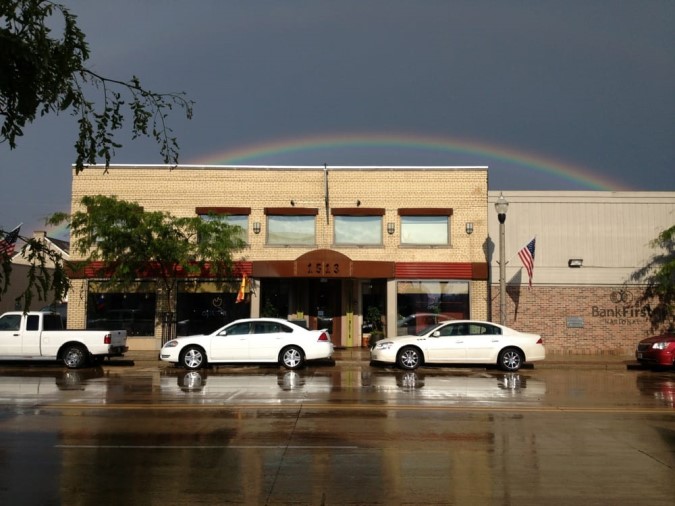October 2013 — Embracing the internet can help downtown businesses grow and compete. This article summarizes the responses to a survey concerning access to and use of broadband in downtown districts. The sample consists of the 35 responses received from downtown development and Main Street professionals in Wisconsin, Illinois, and Ohio. This was not a rigorously scientific survey, but the responses can still provide useful insight on downtown development and the internet.
Quality of Connectivity
It is difficult to draw conclusions regarding the percent of downtown businesses with adequate internet access because only 10 of the 35 respondents knew or were able to estimate this percentage for their downtowns. The average response was 62%. Clearly, many downtown development professionals do not know how well-connected their downtowns are.
Wi-Fi Access
Most food and beverage establishments in the sample downtowns do not offer free Wi-Fi for customers. 18 survey respondents knew what percent of food and beverage purveyors in their downtown offer free Wi-Fi, and the average of these responses was 36%. Responses were highly variable, however, ranging from 0% to 80%. Additionally, only 4 of 35 respondents reported that their downtowns offer free Wi-Fi accessible throughout the district.
Wi-Fi Promotion
Wi-Fi access can bring new customers downtown. However, most survey respondents were either unaware of how Wi-Fi access was being promoted in their downtowns or did not think local promotion efforts were notable. Of those respondents who shared the ways local downtown businesses promote Wi-Fi access, most said that businesses only advertised internet access with signs in windows.
Examples of Successful Internet Use
Many survey respondents shared the names of businesses in their downtown districts that are successfully using the internet to increase business. Below are some examples of ways these businesses are harnessing the power of the internet.
- Studio 115 Photography in Edgerton cut their advertising budget by 90% by using their website and Facebook for
- eBay helps augment in-store sales for Rosie Hart Gifts and Collectibles in Rice
- Purloin Studio in Menomonee Falls has a professionally designed website and utilizes free services including Twitter, Facebook, Yelp, and Google
- Coupons on Living Social and Groupon have helped Peace Yoga Studio in Menomonee Falls reach a wider
- The owner of the consignment boutique Sixth Avenue in Kenosha posts two items per day on Facebook; customers often come in on the same day to check out the
- Google Analytics helped The Planted Seed in Wausau learn about customer demographics.

Case Study: The Remedy Pub and Eatery
When new owners took over The Remedy Pub and Eatery in Two Rivers, Wisconsin in January 2013, they quickly realized that traditional advertisements were not sufficient. “We spent thousands of dollars on newspaper and radio advertising,” said manager Kim Wells, “No matter how much of that we did, nothing seemed to be working.” So the new owners turned to the internet.
The Remedy had a website professionally built and worked on their Facebook page. They soon received positive feedback. Customers were using their online menu when ordering takeout and using their website to ask about events.
The Remedy uses Facebook to advertise weekly and daily specials, new beers, and other promotions. They also frequently compliment their employees and distributors via
Facebook. “I posted something for a new beer on tap and I made sure to mention that our awesome Miller Lite delivery driver just tapped a brand new keg,” wrote Ms. Wells, “When I post something regarding Miller Lite I typically see my distributor, his co-worker, and their boss in here for a beer.”
To bring customers back to the website and Facebook page, and thus back to the restaurant, The Remedy updates its website and Facebook page often. Businesses in small communities often think they don’t need websites, and that people will know where to find them. But today, even in a small town, many people research their shopping, dining, and service options online, so online presence is essential.
How the Internet is Helping Downtowns
Most survey respondents agreed that websites and social media allow downtown businesses to show potential customers the different goods and services available downtown. However, the internet can help improve business downtown in numerous other ways.
The internet also allows businesses to communicate with each other and cross- promote. Many business owners provide links to the websites of nearby businesses on their websites or share those businesses’ promotions on Facebook. In addition to facilitating communications between businesses, internet access allows business owners to easily communicate with customers. One development professional reported that because of broadband access, businesses in her community can respond quickly to questions and comments.
Additionally, Wi-Fi access can bring new customers downtown. One survey respondent commented that college students frequently study in the coffee shops with Wi-Fi in his downtown district. Another shared that due to Wi-Fi access, community members who work from home will often instead work downtown at a coffee shop, a restaurant, or the library.
Even if only a few downtown businesses offer Wi-Fi access to customers, people that come downtown to use the internet at a coffee shop or the library will frequently visit surrounding businesses.
Summary
Although our survey sample indicates that not all Wisconsin downtowns have adequate internet access, and the majority of businesses do not offer free Wi-Fi to customers, internet access has beneficial effects on downtowns.
Downtown businesses can use the internet for communication and low-cost advertising, and internet access can bring new customers downtown. When properly utilized, the internet can be a powerful tool for downtown development.
This article was prepared by Rachel Schuh, a student at Carleton College and Research Intern at the University of Wisconsin-Extension Center for Community & Economic Development.


 Rural Pharmacies an Overlooked Piece of the Rural Health Care System
Rural Pharmacies an Overlooked Piece of the Rural Health Care System The Economics of Downtown Revitalization: Putting Some “Oomph” Behind the Numbers
The Economics of Downtown Revitalization: Putting Some “Oomph” Behind the Numbers The Hotel Industry: Recovery and Future Development in Our Communities
The Hotel Industry: Recovery and Future Development in Our Communities Focus Group Analysis Tips
Focus Group Analysis Tips


